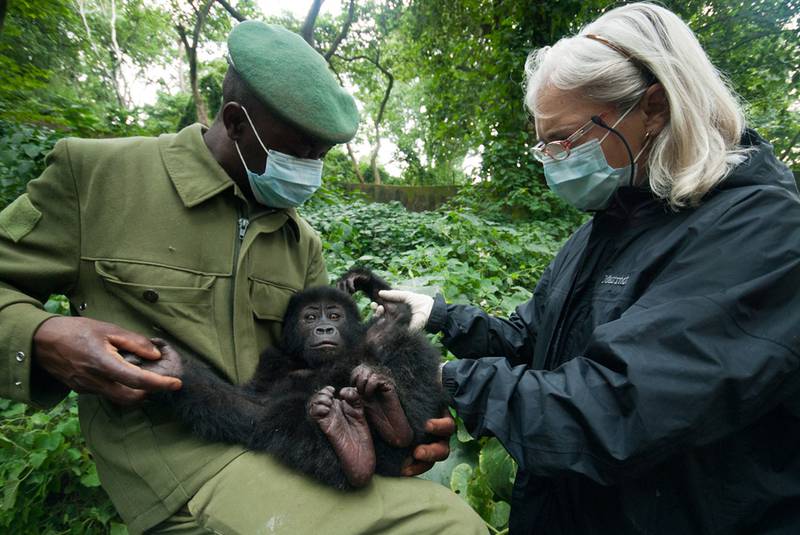Orphaned Gorilla Care
Categories: Grauer's Gorilla, Mountain Gorilla, Eastern gorillas, Rwanda, Democratic Republic of the Congo, Threats, Bushmeat, Journal no. 43, Gorilla Journal
Gorilla confiscations are on the rise in the Democratic Republic of the Congo. So far this year 3 eastern lowland, or Grauer’s gorillas have been confiscated by ICCN (Institut Congolais pour la Conservation de la Nature) – Kyasa, Lubutu and in October 2011 little Shamavu. And in the second half of 2010 Ndjingala and Ihome were confiscated. In Gisenyi, Rwanda, on the border of Goma, DRC, an infant mountain gorilla was confiscated in early August of 2011, just as she was being smuggled across the border. Ihirwe is the first mountain gorilla to be confiscated since 2003. Is this because wildlife authorities are getting better at finding them, or is the traffic in baby gorillas on the rise? Either way, these poor little ones have gone through unthinkable trauma, almost certainly seeing family members killed, very roughly treated by their captors, fed wildly inappropriate diets before they were finally, and luckily confiscated from the poachers.
When these infants are confiscated, they are emotionally traumatized, to say the least, but physical trauma is common. We have had infants come to us with gunshot wounds, pneumonia, deep cuts in their sides from rope leashes, and diarrhea. As soon as we can after confiscation, Gorilla Doctors conduct a quick and gentle examination to determine the extent of injuries and illness, and try to begin appropriate treatment. The next most important thing to ensure recovery is to place the infant in the care of a stable and experienced caregiver. These infants are stressed, sick, tense and withdrawn, and generally between 1 and 3 years of age when they come to us. They need to regain trust – gorilla infants rely on their mothers for nursing, protection, and comfort for the first 3 years of their lives, and the caregiver must provide these essential elements to the infant.
Caregivers are all tested for infectious diseases and, at first, wear coveralls, masks and gloves to decrease the chance of spreading human disease to these extremely susceptible infants (gorillas can get all of the diseases we do, and are especially susceptible to respiratory disease). We Gorilla Doctors also wear masks and coveralls for the same reason. Once the orphan has settled in to his/her new situation, after about a week, we conduct a thorough examination under light anesthesia. Samples are collected for evaluation, the infant is tested for tuberculosis, vaccinated against rabies, tetanus and measles, and treated for parasites. All gorillas confiscated from poachers go through a 30 day quarantine period before being introduced to other gorillas – again, to try to reduce the possibility of transmitting disease either way.
The ideal goal for these orphans is reintroduction back into their native habitat, but the infants are too young to survive, and would not likely be accepted back into their groups even if the family groups could be found. There are many things to consider before an orphan primate can be reintroduced, and this is why a Technical and Scientific Advisory Committee was formed some years ago to bring together the wildlife authorities and others. This committee is composed of representatives from ICCN, RDB (Rwandan Development Board), UWA (Ugandan Wildlife Authority), DFGFI (Dian Fossey Gorilla Fund International), IGCP (International Gorilla Conservation Programme), MGVP (Mountain Gorilla Veterinary Project), GVTS (Greater Virunga Transboundary Secretariat), and meets at least annually to discuss the progress of the orphans and come to consensus on the next steps for their rehabilitation. These gorillas will not be reintroduced to the wild without knowing they have the behavioural tools to survive, that the area into which they will be reintroduced is politically secure, that they have a strong silverback in the group to protect and lead them, and that they do not carry any infectious diseases that might cause serious disease in the wild gorillas. This is a tall order and will take years to achieve.
In the meantime the orphaned Grauer’s gorillas will live in a semi-free ranging situation at the Gorilla Rehabilitation and Conservation Education center (GRACE) in Kasugho, DRC, and the mountain gorillas in Senkwekwe Center at Rumangabo, DRC. Both are great situations where the gorillas can be together, and learn to be gorillas again, under the watchful eyes of caregivers.
At the end of the day, these confiscated gorilla orphans are the lucky ones – their wounds and diseases are treated, they have a good almost natural diet, and they get to be gorillas. I do not like to think about what happens to the orphans that we do not know about.
Jan Ramer

